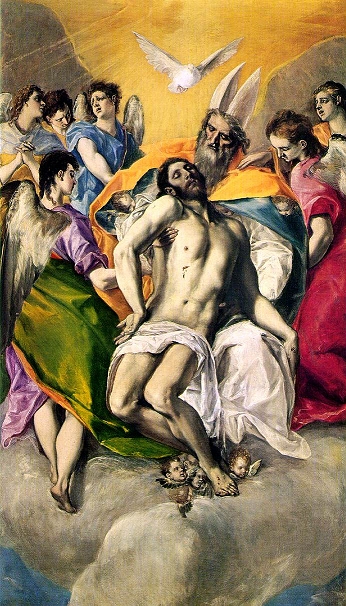Masterpieces
I had the absolute pleasure to take a tour of the Prado museum last week, considered one of the most important art museums in the world. It was a tour lead in Spanish by my school, so it was doubly educational. We saw the works of El Greco, Goya, and Velasquez.
- El Greco I liked mostly for his use of color. He painted either religious paintings or portraits of nobels in Toledo. All the religious paintings had a formula - long bodies, two halves signifying the earth and heaven, and symbolic colors. In the following picture, “The Holy Trinity” you can see these characteristics. Some say he painted long bodies because he had vision problems, others say he did so to symbolize the spirit stretching to the heaven. I choose to believe the second hypothesis, especially because his portraits didn’t seem distorted. God is dressed in royal colors of gold and blue. Mary was always painted in blue and red.

- Goya I liked least. I think most of his works are in France since he died there. The Prado houses the 2nd and 3rd of May, paintings depicting the uprising of the Madrilenos against the French. What most interested me, if not for their content but for the thoughts behind them, is the full collection of Goya’s Black Paintings. Found in his Spanish home by a grandson, they give a glimpse into his mind. Whether he was crazy or depressed by the state of Spain (they were painted soon before he left) is up for debate. They seem extremely personal to me, especially since he chose to surround himself with them. One of the most famous is “Saturn Devouring His Children.” It may be a commentary from Goya saying that the monarchy is bad for Spain, especially since the body seems to be a woman and España is a feminine country (ends in “a”.) Also, the body’s right arm and head is gone, maybe symbolic for the oppression of the people.

- Velasquez was by far my favorite. The man was a genius, with a library for his own using in the palace. I feel like I have less to say about his works because I was content to sit and look, rather than listen to the tour. Some of the paintings we saw of his where those that mixed greek/roman mythology with every day life. He liked the stories, but lived in a time when the church did not. Therefore, he disguised mythological stories in what where depictions of incredibly relevant scenes from Spain at the time. His use of symbols and hints is overwhelming. Then we saw “Las Meninas.” Wow. One of the most analyzed works in western art, it is breathtaking. Number one its huge, number two it is very complex. No one can agree who Velasquez - in the painting itself - was painting. Some say it was the Princess Margarita, in the center, others say it was the King and Queen, who can be seen in the reflection of the mirror in the back. Something else interesting we saw are known as arrepentimientos. These are changes in the painting that over time have become visible. For example, in one painting Velasquez moved someones foot to a different spot after he was nearly done.

If you’ve read this far its obvious to me you like art. You MUST go the the Prado. I can’t wait to see the rest of it, especially the Rembrandt!!